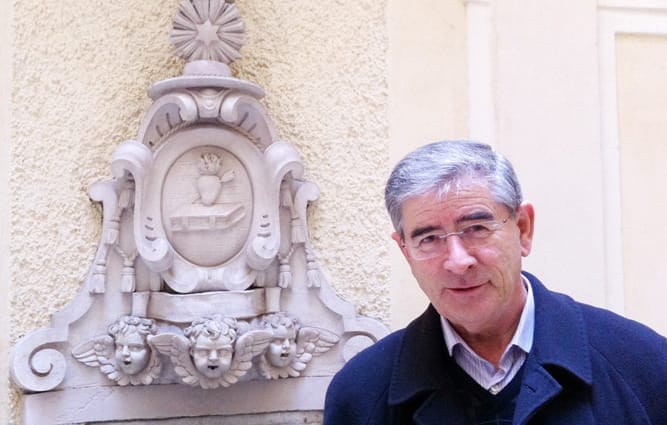Q.- What is exactly your task?
R.- The religious in-charge is the liaison between the Congregation for Religious of the Vatican and Federation of nuns. Each of the monasteries is subjected to its respective diocesan bishop. The founder of the Augustinian Recollect contemplative nuns, Mariana de San José wanted it thus (1568-1638). But at the same time, the nuns are governed by their proper constitutions that are common and have been approved by the Congregation for Religious. This allows the monasteries for practical reason to form a federation, and the office of the religious in-charge is understood within this framework.
National Patrimony
Q.- We are talking about very old monasteries: How are these edifices? How are they preserved?
R.- Of the 27 Spanish monasteries, some have reached 400 years already, even though there are also other monasteries, which are more recent. With respect to their state, generally, they are very well preserved, because in almost all monasteries, they had been doing improvements. Some are noble and monumental buildings. For example, the two monasteries of Madrid ( La Encarnación and Santa Isabel ) belong to the National Heritage. The monastery of Salamanca has La Purísima, a very beautiful Church, or that of Palencia, next to the Cathedral. Generally these are very important works and are well cared for.
Elders
 Q.- Let us now go to the human aspect: how would you describe it?
Q.- Let us now go to the human aspect: how would you describe it?
R.- The Spanish nuns are advanced in age: they have an average age of 70 years; it is necessary to note that the foreigners lower the average age, since most of them are young. Firstly, they are Mexicans, who have come to help the Spanish monasteries, but they continue to be incardinated to their convent of origin. Then, there are some fifteen Indians, and a good group of Africans, coming from Tanzania and Kenya. Lastly, some come from Guatemala, specially through the Monastery of Serradilla (Caceres). There are 70 foreigners out of 250 nuns.
Treasure
Q.- What, do you believe, is the principal value of this monasteries?
R.- The most important is its long history, that the charism of the feminine Recollection has perpetuated in these convents, and around which, an enormous cultural patrimony has been formed. It is a treasure that is at risk now, seriously enough, despite the fact that the nuns refuse to leave their convents. They prefer to live this way, almost in an agonizing state, rather than leave their monasteries.
Vocations
Q.- What is their major problem?
R.- Right now the principal problem is vocational, which brings with itself a human problem, since the nuns are already very advanced in age and cannot live their life with the required vitality. The communities exude an air, which is a bit deadening. Some of the nuns see it with much preoccupation and anguish: Are we closing? Are we not closing? They wait for help from other places. This was easy before, but today it is not, since the need is universal. The Federation of Mexico continuously extends help very generously for at least 30 years. Now the Mexicans continuously come, but lesser in number.
Fellowship
 Q.- This new factor of abundance of foreign vocations, how does it affect the condition of life in the monasteries?
Q.- This new factor of abundance of foreign vocations, how does it affect the condition of life in the monasteries?
R.- It conditions in particular way the fellowship, though until now, there had been no major problems. But, undoubtedly, the customs and the same mentality are going to suffer changes, as consequence of the different cultures, which converge in the convents. But until now, there had been no much admixture of culture, since the foreigners are quite localized: the Indians are in certain convents and the same goes to the Africans.
Philippines
Q.- You have been in the Philippines recently: how have you seen the monastery of Bacolod?
R.- Philippines is 17 years old since its foundation. In 2011 it obtained its canonical recognition, in such a way that it does not depend anymore from the Federal President, but it is a totally autonomous monastery. But it is in a quite precarious situation. It has been believed that in the Philippines, there would be many vocations, but it has not been that way. Yes, many young women have tried, but they did not fit in. At present, there are eight professed nuns, but one is temporarily at home and another would be going to Kenya to help for a time.
Kenya
 Q.- And the monastery of Wote, in Kenya?
Q.- And the monastery of Wote, in Kenya?
R.- In Kenya, the situation is very different. In the convent of Wote belonging to the Federation of Spain, one of the two convents in Kenya, there are actually 25 persons, 10 professed, four novices and the rest are postulants. There are only three foreigners among them: one Mexican, one Spaniard and one Filipina.
India and Peru
Q.- Are there any other possible foundations in consideration?
R.- In the 10th Federal Assembly (August 2011), a letter of an Indian nun was read, endorsed by a bishop of that country, who was requesting a foundation there. And there was also another petition to found in Peru. In the Assembly, both proposal were considered with sympathy, but also with realism, recognizing that they neither have the persons nor the means to realize such foundations.


